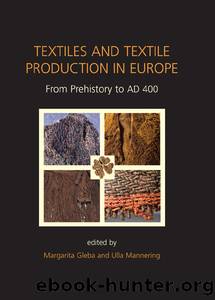Textiles and Textile Production in Europe by Unknown

Author:Unknown
Language: eng
Format: epub
ISBN: XXXXXXXXXXXXX
Publisher: Casemate Publishers & Book Distributors, LLC
Published: 2012-02-27T16:00:00+00:00
10
Case Study:
The Textiles from Verucchio, Italy
Annemarie Stauffer
Fig. 10.1. Verucchio, tomb 89 (Tomba del trono): Fragment of a looped textile found among the remains of the pyre (© Cologne University of Applied Sciences).
Introduction
Knowledge of the clothing types and clothing traditions of Pre-Roman Italy is principally based on the Etruscan culture with its detailed iconographic record preserved in the form of wall paintings and sculptures, depicting colourful dresses and decorative textiles such as blankets, cushions and canopies (cf. Steingräber 1985; Bonfante 1975/2003). However, for the pre-Etruscan, so-called Villanovan culture, such illustrative representations of garments are largely missing, although material compiled by Larissa Bonfante in her seminal Etruscan Dress (1975/2003) reflects a high level of textile technology already in the Late Bronze/ Early Iron Age. Nearly all research on Pre-Roman costume in Italy has been based on interpretations of these sources, as relatively few original textiles survive (cf. Gleba 2008 and in this volume). Thus, basic information on textiles and garments in Villanovan times is largely missing, e.g. information on material and binding used for textile production, on colours and colour schemes, and on additional decoration such as embroidery or appliqués. The Villanovan textiles from Verucchio have changed this situation, yielding a great deal of detailed information on materials, colours and tools used for textile production in the Early Iron Age. The finds from Verucchio are testimony to sophisticated weaving methods and techniques. Moreover, dyestuff analyses give a clear idea of colours used and preferred by the contemporary aristocracy. The large spectrum of finds from different tombs provides reliable information about textiles and clothing. Furthermore, the textiles from princely tombs reflect social importance as well as individual wealth: they are symbols of status and identity.
Download
This site does not store any files on its server. We only index and link to content provided by other sites. Please contact the content providers to delete copyright contents if any and email us, we'll remove relevant links or contents immediately.
POP by Steven Heller(3307)
Japanese Design by Patricia J. Graham(3109)
The Power of Broke by Daymond John(2897)
Architecture 101 by Nicole Bridge(2764)
Indistractable: How to Control Your Attention and Choose Your Life by Nir Eyal(2333)
Fusion 360 for Makers by Lydia Sloan Cline(2308)
Batik by Rudolf Smend(2123)
Actionable Gamification: Beyond Points, Badges, and Leaderboards by Yu-kai Chou(2122)
Origami Art by Michael G. Lafosse & Richard L. Alexander(2065)
Homebody by Joanna Gaines(2031)
Whiskey in a Teacup by Reese Witherspoon(1936)
Worn in New York by Emily Spivack(1926)
Feng Shui by Stephen Skinner(1900)
Austin Kleon by Steal Like an Artist(1887)
Simple Gatherings by Melissa Michaels(1855)
Don't Make Me Think, Revisited: A Common Sense Approach to Web Usability by Steve Krug(1826)
Hygge: The Danish Art of Happiness by Marie Tourell Søderberg(1693)
The Joy of Hygge by Jonny Jackson(1685)
The Laws of Simplicity by John Maeda(1568)
